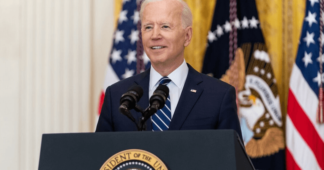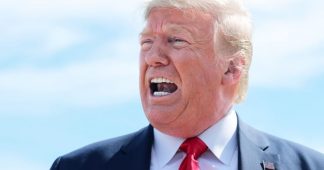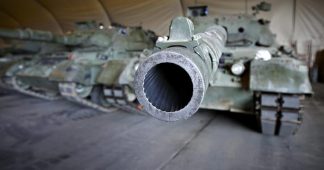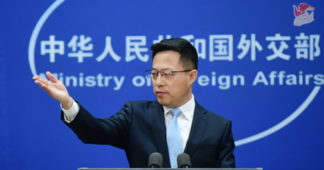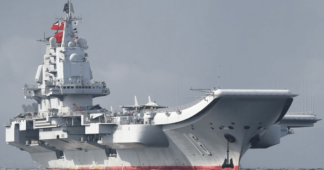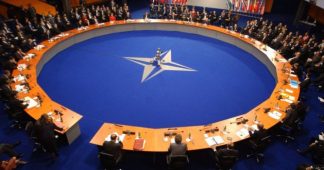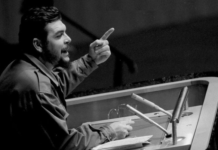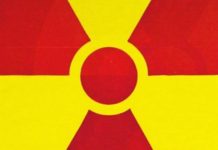Hudson
Apr 7, 2022
It is now clear that today’s escalation of the New Cold War was planned over a year ago. America’s plan to block Nord Stream 2 was really part of its strategy to block Western Europe (“NATO”) from seeking prosperity by mutual trade and investment with China and Russia.
As President Biden and U.S. national-security reports announced, China was seen as the major enemy. This despite China’s helpful role in enabling corporate America to drive down labor’s wage rates by de-industrializing the U.S. economy in favor of Chinese industrialization, China’s growth was recognized as posing the Ultimate Terror: prosperity through socialism. Socialist industrialization always has been perceived to be the great enemy of the rentier economy that has taken over most nations in the century since World War I ended, and especially since the 1980s. The result today is a clash of economic systems – socialist industrialization vs. neoliberal finance capitalism.
That makes the New Cold War against China an implicit opening act of what threatens to be a long-drawn-out World War III. The U.S. strategy is to pry away China’s most likely economic allies, especially Russia, Central Asia, South Asia and East Asia. The question was, where to start the carve-up and isolation.
Russia was seen as presenting the greatest opportunity to begin isolating, both from China and from the NATO Eurozone. A sequence of increasingly severe – and hopefully fatal – sanctions against Russia was drawn up to block NATO from trading with it. All that was needed to ignite the geopolitical earthquake as a casus belli.
That was arranged easily enough. The escalating New Cold War could have been launched in the Near East – over resistance to America’s grabbing of Iraqi oil fields, or against Iran and countries helping it survive economically, or in East Africa. Plans for coups, color revolutions and regime change have been drawn up for all these areas, and America’s African army has been built up especially fast over the past year or two. But Ukraine has been subjected to a U.S.-backed civil war for eight years, since the 2014 Maidan coup, and offered the chance for the greatest first victory in this confrontation against China, Russia and their allies.
So the Russian-speaking Donetsk and Luhansk regions were shelled with increasing intensity, and when Russia still refrained from responding, plans reportedly were drawn up for a great showdown to commence in late February – beginning with a blitzkrieg Western Ukrainian attack organized by U.S. advisors and armed by NATO.
Russia’s preemptive defense of the two Eastern Ukrainian provinces and its subsequent military destruction of the Ukrainian army, navy and air force over the past two months has been used as the excuse to start imposing the U.S.-designed sanctions program that we are seeing unfolding today. Western Europe has dutifully gone along whole-hog. Instead of buying Russian gas, oil and food grains, it will buy these from the United States, along with sharply increased arms imports.
The prospective fall in the Euro/Dollar exchange rate
It therefore is appropriate to look at how this is likely to affect Western Europe’s balance of payments and hence the euro’s exchange rate against the dollar.
European trade and investment prior to the War to Impose Sanctions had promised a rising mutual prosperity between Germany, France and other NATO countries vis-à-vis Russia and China. Russia was providing abundant energy at a competitive price, and this energy was to make a quantum leap with Nord Stream 2. Europe was to earn the foreign exchange to pay for this rising import trade by a combination of exporting more industrial manufactures to Russia and capital investment in developing the Russian economy, e.g. by German auto companies and financial investment. This bilateral trade and investment is now stopped – and will remain stopped for many, many years, given NATO’s confiscation of Russia’s foreign reserves kept in euros and British sterling, and Europe’s Russophobia being fanned by U.S. propaganda media.
In its place, NATO countries will purchase U.S. LNG – but they will need to spend billions of dollars building sufficient port capacity, which may take until perhaps 2024. (Good luck until then.) The energy shortage will sharply raise the world price of gas and oil. NATO countries also will step up their purchases of arms from the U.S. military-industrial complex. The near-panic buying will also raise the price for arms. And food prices also will rise as a result of the desperate grain shortfalls resulting from a cessation of imports from Russia and Ukraine on the one hand, and the shortage of ammonia fertilizer made from gas.
All three of these trade dynamics will strengthen the dollar vis-à-vis the euro. The question is, how will Europe balance its international payments with the United States? What does it have to export that the U.S. economy will accept as its own protectionist interests gain influence, now that global free trade is dying quickly?
The answer is, not much. So what will Europe do?
I could make a modest proposal. Now that Europe has pretty much ceased to be a politically independent state, it is beginning to look more like Panama and Liberia – “flag of convenience” offshore banking centers that are not real “states” because they don’t issue their own currency, but use the U.S. dollar. Since the eurozone has been created with monetary handcuffs limiting its ability to create money to spend into the economy beyond the limit of 3 percent of GDP, why not simply throw in the financial towel and adopt the U.S. dollar, like Ecuador, Somalia and the Turks and Caicos Islands? That would give foreign investors security against currency depreciation in their rising trade with Europe and its export financing.
For Europe, the alternative is that the dollar-cost of its foreign debt taken on to finance its widening trade deficit with the United States for oil, arms and food will explode. The cost in euros will be even greater as the currency falls against the dollar. Interest rates will rise, slowing investment and making Europe even more dependent on imports. The eurozone will turn into an economic dead zone.
For the United States, this is Dollar Hegemony on steroids – at least vis-à-vis Europe. The continent would become a somewhat larger version of Puerto Rico.
The dollar vis-à-vis Global South currencies
The full-blown version is the New Cold War turning into the opening salvo of World War III triggered by the “Ukraine War”, that’s likely to last at least a decade, perhaps two, as the U.S. extends the fight between neoliberalism and socialism to encompass a worldwide conflict. Apart from the U.S. economic conquest of Europe, its strategists are seeking to lock in African, South American and Asian countries along similar lines to what has been planned for Europe.
The sharp rise in energy and food prices will hit food-deficit and oil-deficit economies hard – at the same time that their foreign dollar-denominated debts to bondholders and banks are falling due and the dollar’s exchange rate is rising against their own currency. Many African and Latin American countries – especially North Africa – face a choice between going hungry, cutting back their gasoline and electricity use, or borrowing the dollars to cover their dependency on U.S.-shaped trade.
There has been talk of IMF issues of new SDRs to finance the rising trade and payments deficits. But such credit always comes with strings attached. The IMF has its own policy of sanctioning countries that do not obey U.S. policy. The first U.S. demand will be that these countries boycott Russia, China and their emerging trade and currency self-help alliance. “Why should we give you SDRs or extend new dollar loans to you, if you are simply going to spend these in Russia, China and other countries that we have declared to be enemies,” the U.S. officials will ask.
At least, this is the plan. I would not be surprised to see some African country become the “next Ukraine,” with U.S. proxy troops (there are still plenty of Wahabi advocates and mercenaries) fighting against the armies and populations of countries seeking to feed themselves with grain from Russian farms, and power their economies with oil or gas from Russian wells – not to speak of participating in China’s Belt and Road Initiative that was, after all, the trigger to America’s launching of its new war for global neoliberal hegemony.
The world economy is being enflamed, and the United States has prepared for a military response and weaponization of its own oil and agricultural export trade, arms trade and demands for countries to choose which side of the New Iron Curtain they wish to join.
But what is in this for Europe? Greek labor unions already are demonstrating against the sanctions being imposed. And in Hungary, Prime Minister Viktor Orban has just won an election on what is basically an anti-EU and anti-U.S. worldview, starting with paying for Russian gas in roubles. How many other countries will break ranks – and how long will it take?
What is in this for the Global South countries being squeezed – not merely as “collateral damage” to the deep shortages and soaring prices for energy and food, but as the very objective of U.S. strategy as it inaugurates the great splitting of the world economy in two? India has already told U.S. diplomats that its economy is naturally connected with those of Russia and China.
From the U.S. vantage point, all that needs to be answered is, “What’s in it for the local politicians and client oligarchies that we reward for delivering their countries?”
That is what makes the looming World War III a veritable war of economic systems. What side will countries choose: their own economic interest and social cohesion, or the U.S. diplomacy put in the hands of their political leaders? When combined with U.S. meddling along the lines of the $5 billion that Assistant Secretary of State Victoria Nuland bragged of having invested in Ukraine’s neo-Nazi parties eight years ago to initiate the fighting erupting in today’s war, there is a lot to consider.
In the face of all this political meddling and media propaganda, how long will it take the rest of the world to realize that there’s a global war on as it expands into World War III? The real problem is that by the time it understands what is going on, the global fracture will already have enabled Russia, China and Eurasia to create a real non-neoliberal New World Order that does not need NATO countries, having lost trust and hope for mutual economic gains. The military battlefield will be littered with economic corpses.
We remind our readers that publication of articles on our site does not mean that we agree with what is written. Our policy is to publish anything which we consider of interest, so as to assist our readers in forming their opinions. Sometimes we even publish articles with which we totally disagree, since we believe it is important for our readers to be informed on as wide a spectrum of views as possible.
